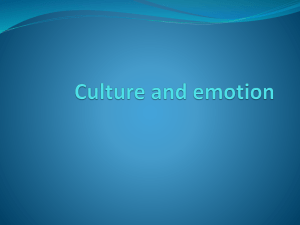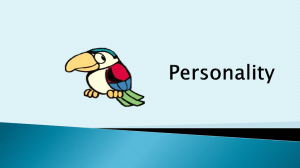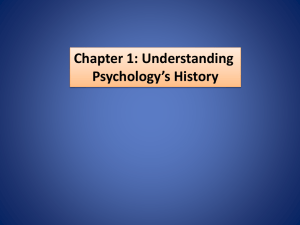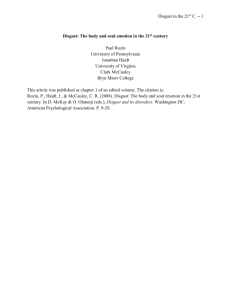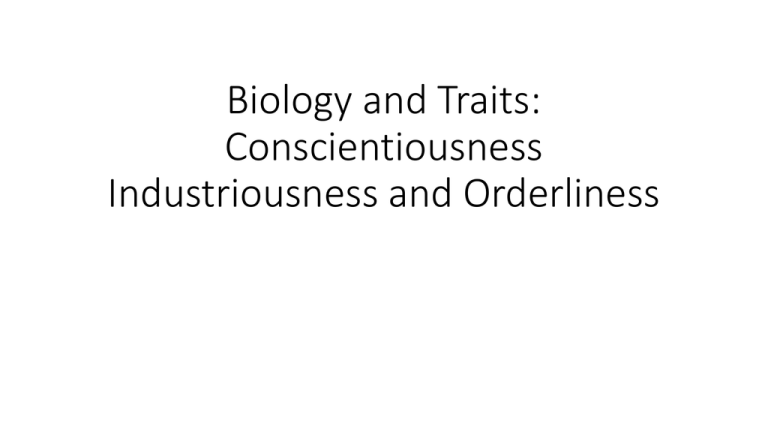
Biology and Traits:
Conscientiousness
Industriousness and Orderliness
Extraversion
Assertiveness
r = .47
Enthusiasm
PLASTICITY
Openness
Openness
r = .35
Intelligence
• Average correlation between Big Five
• Correlation between Big Two
r = .22
r = .24
STABILITY
Conscientiousness
Industriousness
r = .39
Orderliness
Emotional Stability
Volatility
r = .59
Withdrawal
Agreeableness
Politeness
r = .44
Compassion
• Orderliness
•
•
•
•
•
•
•
•
•
•
Leaves belongings around.
Likes order.
Keeps things tidy.
Follows a schedule.
Is not bothered by messy people.
Wants everything to be “just right.”
Is not bothered by disorder.
Dislikes routine.
Sees that rules are observed.
Wants every detail taken care of.
• Industriousness
•
•
•
•
•
•
•
•
•
•
Carries out his/her plans.
Wastes time.
Finds it difficult to get down to work.
Messes things up.
Finishes what he/she starts.
Doesn't put his/her mind on the task at
hand.
Gets things done quickly.
Always knows what he/she is doing.
Postpones decisions.
Is easily distracted.
Conscientiousness: The Mystery
• No theoretical model
• No neuropsychological model
• No psychological model
• No pharmacological model
Dorsolateral Prefrontal Cortex?
• No correlation with DLPFCA function
• Description: Conscientiousness
• Tendency to be planful, organized, task- and goal-oriented, and self-controlled, and to
delay gratification and follow norms and rules (Roberts et al. 2009)
•
Affect/Emotion
• Strongly related to life satisfaction and “happiness”
• DeNeve, K. M., & Cooper, H. (1998). The happy personality: A meta-analysis of 137
personality traits and subjective well-being. Psychological Bulletin, 124, 197–229.
• Heller, D., Watson, D., & Ilies, R. (2004). The dynamic process of life satisfaction. Journal
of Personality, 74, 1421–1450.
• Conscientiousness related to depression
• Guilt: Fayard, J.V et al. (2012). Uncovering the affective core of conscientiousness.
Journal of Personality, 80, 1-32.
• “Study 1 used meta-analysis to show that Conscientiousness was associated with specific
emotions and overall negative affect but was most strongly associated with guilt.
Conscientiousness was negatively related to guilt experience but positively related to guilt
proneness.”
Orderliness
• Conservatism
• Along with low openness
• Disgust Sensitivity
• Preference for order and tradition
• Not egalitarianism
• Harsh judgements of moral transgression
• “Behavioral Immune System”
• Disgust is considered to be one of the basic human emotions, defined by
a strong revulsion and desire to withdraw from an eliciting stimulus or
event (Darwin, 1872; Rozin, Haidt, & McCauley, 2000).
• Physically, disgust is accompanied by a distinct facial expression involving
constriction of the oral and nasal cavities (Ekman & Friesen, 2003; Vrana,
1993).
• Evolutionary models of disgust propose that this emotion evolved to help
us avoid contaminated or harmful foods (Rozin & Fallon, 1987), or other
potential sources of disease such as sexual contact (Oaten, Stevenson, &
Case, 2009).
• In addition to its role in directly helping to expel harmful foods from the
body, disgust also forms an important component of the behavioral
immune system, the suite of psychological mechanisms that aid in the
detection and avoidance of potential contaminants before they can make
contact with the body (Schaller & Duncan, 2007; Schaller & Park, 2011).
• Although disgust may have its origins in the protection against
physical contamination, a number of studies have implicated disgust
responses in moral decision-making.
• Inducing disgust responses, whether via a foul odor, a disgusting work
environment, or recalling a disgusting experience, led individuals to
assign harsher punishments to others who had committed moral
transgressions (Schnall, Haidt, Clore, & Jordan, 2008; Wheatley &
Haidt, 2005).
• Harsher moral judgments can even be induced following the
consumption of a bitter drink (Eskine, Kacinik, & Prinz, 2011). In
addition, the same disgust-related facial expressions are observed in
response to unpleasant tastes, disgusting photographs, and receiving
unfair treatment in an economic game (Chapman, Kim, Susskind, &
Anderson, 2009).
• Concerns about cleanliness and feelings of disgust have likewise been related to
political attitudes.
• Situational reminders of the importance of physical cleanliness, such as asking
participants to wipe their hands with antiseptic wipes, tend to increase selfreported political conservatism (Helzer & Pizarro, 2011).
• Such a finding is consistent with the notion that purity tends to be valued more
highly by conservatives than by liberals (Graham, Haidt, & Nosek, 2009).
• Individuals who report being disgusted more easily also tend to hold more
conservative political views on topics including abortion, gay marriage, tax cuts,
and affirmative action (Inbar, Pizarro, Iyer, & Haidt, in press; Inbar, Pizarro, &
Bloom, 2009).
• In addition to the effects that have emerged when using self-reported disgust
sensitivity, more conservative political views have also been associated with
stronger physiological reactivity to disgusting images (Smith, Oxley, Hibbing,
Alford, & Hibbing, 2011).
• In particular, a large literature has converged on the notion that there are two
core dimensions of conservative political ideology: resistance to change and
tolerance of inequality (Jost, 2006; Jost, Federico, & Napier, 2009; Jost, Glaser,
Kruglanski, & Sulloway, 2003; Jost, Nosek, & Gosling, 2008).
• Resistance to change reflects the extent to which people wish to maintain the
status quo, while tolerance of inequality reflects the acceptance of an unequal
distribution of resources and opportunities within society.
• These two dimensions appear roughly aligned with social and economic
conservatism, as expressed in the constructs of Right-Wing Authoritarianism
and Social Dominance Orientation, respectively (Duckitt, Wagner, Du Plessis, &
Birum, 2002).
• These core facets of conservatism are also closely related to the two higher-order
value dimensions described in moral foundations theory, which reflect
preferences for order and tradition on the one hand, and preferences for
egalitarianism on the other (Graham et al., 2009; Graham et al., 2011).
• Importantly, the motivational bases of these two dimensions appear to vary
independently from one another, with an individual’s overall political attitudes on
a left-right spectrum emerging from their relative balance.
• These motives are also strongly rooted in basic personality characteristics, such
that preferences for order and tradition are associated with higher levels of
Orderliness (an aspect of Conscientiousness) and Politeness (an aspect of
Agreeableness), as well lower levels of Openness/Intellect;
• in contrast, preferences for egalitarianism are uniquely associated with
Compassion, an aspect of Agreeableness (Caprara, Schwartz, Capanna,
Vecchione, & Barbaranelli, 2006; Carney, Jost, Gosling, & Potter, 2008; Hirsh,
DeYoung, Xu, & Peterson, 2010; Jost, 2006)
• political conservatism can be thought of as a “social immune system”, reflecting
the extension of pathogen avoidance mechanisms to the integrity of the social
system (Rozin et al., 2000).
• Just as the behavioral immune system has been conceptualized as helping to
maintain the purity and integrity of an individual body (Schaller & Park, 2011), so
too may the same pathogen avoidance system help to maintain the abstract
integrity of the social order.
• In particular, the social immune system would help to maintain order by
suppressing any actions or individuals that deviate from a group’s accepted social
traditions.
• It has been reported, for instance, that regions with higher levels of disease
prevalence tend to be associated with higher levels of social conformity (Murray,
Trudeau, & Schaller, 2011) and autocratic rule (Thornhill, Fincher, & Aran, 2009).
• Individuals who feel more vulnerable to disease likewise report higher levels of
ethnocentrism and xenophobia (Navarrete & Fessler, 2006).
• Such basic concerns about pathogen avoidance may thus contribute to the desire
for order and tradition among conservatives, along with the harsh moral
judgments associated with violations of the social order.
• In particular, severe moral judgments may be a key mechanism by which the
social immune system (instantiated in conservative practices and policies) aims to
eliminate exposure to deviant social elements that may increase the risk of
pathogen exposure.
Parasite Stress Hypothesis
• According to a "parasite stress" hypothesis, authoritarian
governments are more likely to emerge in regions characterized by a
high prevalence of disease-causing pathogens. Recent cross-national
evidence is consistent with this hypothesis, but there are inferential
limitations associated with that evidence. We report two studies that
address some of these limitations, and provide further tests of the
hypothesis.
• Study 1 revealed that parasite prevalence strongly predicted crossnational differences on measures assessing individuals' authoritarian
personalities, and this effect statistically mediated the relationship
between parasite prevalence and authoritarian governance. The
mediation result is inconsistent with an alternative explanation for
previous findings. To address further limitations associated with
cross-national comparisons,
• Study 2 tested the parasite stress hypothesis on a sample of
traditional small-scale societies (the Standard Cross-Cultural Sample).
Results revealed that parasite prevalence predicted measures of
authoritarian governance, and did so even when statistically
controlling for other threats to human welfare. (One additional
threat—famine—also uniquely predicted authoritarianism.)
• Together, these results further substantiate the parasite stress
hypothesis of authoritarianism, and suggest that societal differences
in authoritarian governance result, in part, from cultural differences in
individuals' authoritarian personalities.
Table 2. Results from analyses on the Standard Cross Cultural Sample (Study 2): Zero-order correlations
between 12-item index of authoritarian governance, two measures of parasite stress, and three measures
assessing other threats to health and welfare.
Murray DR, Schaller M, Suedfeld P (2013) Pathogens and Politics: Further Evidence That Parasite Prevalence Predicts Authoritarianism. PLoS
ONE 8(5): e62275. doi:10.1371/journal.pone.0062275
http://www.plosone.org/article/info:doi/10.1371/journal.pone.0062275
Hitler
Along with his plans for the Welthauptstadt Germania ("world capital
Germania"), Albert Speer made the plans for the world's largest stadium which
was to be located on the rally grounds. Derived from the Panathenaic Stadium
of Athens,[7] it would have offered 400,000 seats. It was to get the shape of a
horseshoe; planned dimensions: length: 800 m, width: 450 m, height: 100 m,
building area 350,000 m².
The laying of the foundation stone was on 9 July 1937. It was to be finished for
the party congress in 1945. In 1938, the construction began with the
excavation. It was stopped in 1939, but during the whole war, the casting pit
had to be kept dry from entering ground water. After the war, the northern half
of the pit filled up with the water and is today called Silbersee (silver lake), the
southern half was used to deposit the debris of the destroyed downtown
Nuremberg. (Wikipedia)
DER JUDE ALS WELTPARASIT
• "...the people of the world will recognize the Jew as World Parasite
and there will be a time when there will be one united front of all
people against the Jewish World Parasite.“
• The pamphlet ends: "And humanity will be freed from the most
severe illness from which it suffered for thousands of years."
• Hitler's Ideology: Embodied
Metaphor, Fantsay, and
History
• Richard Koenigsberg
Festliches Nurnberg – short 1937 propaganda film chronicling the Nazi rallies in Nuremberg in 1936 and 1937 (director: Hans Wiedemann)
•
References
•
Altemeyer, B. (1988). Enemies of freedom: Understanding right-wing authoritarianism: Jossey-Bass.
•
Caprara, G. V., Schwartz, S., Capanna, C., Vecchione, M., & Barbaranelli, C. (2006). Personality and politics: Values, traits, and political choice. Political Psychology, 27(1), 1-28.
•
Carney, D., Jost, J., Gosling, S., & Potter, J. (2008). The secret lives of liberals and conservatives: Personality profiles, interaction styles, and the things they leave behind. Political Psychology, 29(6), 807-840.
•
Chapman, H., Kim, D., Susskind, J., & Anderson, A. (2009). In bad taste: Evidence for the oral origins of moral disgust. Science, 323(5918), 1222.
•
Darwin, C. (1872). The expression of the emotions in man and animals. London, UK: John Murray.
•
DeYoung, C. G., Quilty, L. C., & Peterson, J. B. (2007). Between Facets and Domains: Ten Aspects of the Big Five. Journal of Personality and Social Psychology, 93(5), 880-896.
•
Duckitt, J., Wagner, C., Du Plessis, I., & Birum, I. (2002). The psychological bases of ideology and prejudice: Testing a dual process model. Journal of Personality and Social Psychology, 83(1), 75-93.
•
Ekman, P., & Friesen, W. V. (2003). Unmasking the face: A guide to recognizing emotions from facial clues: Malor Books.
•
Eskine, K. J., Kacinik, N. A., & Prinz, J. J. (2011). A Bad Taste in the Mouth. Psychological Science, 22(3), 295.
•
Faulkner, J., Schaller, M., Park, J. H., & Duncan, L. A. (2004). Evolved disease-avoidance mechanisms and contemporary xenophobic attitudes. Group Processes & Intergroup Relations, 7(4), 333-353.
•
Goldberg, L. R. (1999). A broad-bandwidth, public domain, personality inventory measuring the lower-level facets of several five-factor models. In I. Mervielde, I. J. Deary, F. De Fruyt & F. Ostendorf (Eds.), Personality
Psychology in Europe (Vol. 7, pp. 7-28). Tilburg, The Netherlands: Tilburg University Press.
•
Graham, J., Haidt, J., & Nosek, B. A. (2009). Liberals and conservatives rely on different sets of moral foundations. Journal of Personality and Social Psychology, 96(5), 1029.
•
Graham, J., Nosek, B. A., Haidt, J., Iyer, R., Koleva, S., & Ditto, P. H. (2011). Mapping the moral domain. Journal of personality and social psychology, 101(2), 366.
•
Haidt, J., & Joseph, C. (2007). The moral mind: How 5 sets of innate intuitions guide the development of many culture-specific virtues, and perhaps even modules. In P. Carruthers, S. Laurence & S. Stich (Eds.), The
Innate Mind: Foundations and the Future (Vol. 3). USA: Oxford University Press.
•
Haidt, J., McCauley, C., & Rozin, P. (1994). Individual differences in sensitivity to disgust: A scale sampling seven domains of disgust elicitors. Personality and Individual Differences, 16(5), 701-713.
•
Haslam, N. (2011). The Return of the Anal Character. Review of General Psychology, 15(4), 351-360.
•
Helzer, E. G., & Pizarro, D. A. (2011). Dirty Liberals! Psychological Science, 22(4), 517.
•
Hirsh, J. B., DeYoung, C. G., Xu, X., & Peterson, J. B. (2010). Compassionate Liberals and Polite Conservatives: Associations of Agreeableness With Political Ideology and Moral Values. Personality and Social Psychology
Bulletin, 36(5), 655-664.
•
Hodson, G., & Costello, K. (2007). Interpersonal disgust, ideological orientations, and dehumanization as predictors of intergroup attitudes. Psychological Science, 18(8), 691.
•
Inbar, Y., Pizarro, D., Iyer, R., & Haidt, J. (in press). Disgust Sensitivity, Political Conservatism, and Voting. Social, Psychological and Personality Science.
•
Inbar, Y., Pizarro, D. A., & Bloom, P. (2009). Conservatives are more easily disgusted than liberals. Cognition and Emotion, 23(4), 714-725.
•
Jost, J. T. (2006). The End of the End of Ideology. American Psychologist, 61(7), 651-670.
•
Jost, J. T., Federico, C. M., & Napier, J. L. (2009). Political ideology: Its structure, functions, and elective affinities. Annual Review of Psychology, 60, 307-337.
•
Jost, J. T., Glaser, J., Kruglanski, A. W., & Sulloway, F. J. (2003). Political Conservatism as Motivated Social Cognition. Psychological Bulletin, 129(3), 339-375.
•
Jost, J. T., Nosek, B. A., & Gosling, S. D. (2008). Ideology: Its resurgence in social, personality, and political psychology. Perspectives on Psychological Science, 3(2), 126-136.
•
Kohlberg, L. (1969). Stage and sequence: The cognitive developmental approach to socialization. In D. A. Goslin (Ed.), Handbook of socialization theory and research. Chicago, IL: Rand McNally.
•
Lee, S. W. S., & Schwarz, N. (2011). Wiping the Slate Clean. Current directions in psychological science, 20(5), 307-311.
•
Murray, D. R., Trudeau, R., & Schaller, M. (2011). On the origins of cultural differences in conformity: four tests of the pathogen prevalence hypothesis. Personality and Social Psychology Bulletin, 37(3), 318.
•
Navarrete, C. D., & Fessler, D. M. T. (2006). Disease avoidance and ethnocentrism: The effects of disease vulnerability and disgust sensitivity on intergroup attitudes. Evolution and Human Behavior, 27(4), 270-282.
•
Oaten, M., Stevenson, R. J., & Case, T. I. (2009). Disgust as a disease-avoidance mechanism. Psychological bulletin, 135(2), 303.
•
Olatunji, B. O., Williams, N. L., Tolin, D. F., Abramowitz, J. S., Sawchuk, C. N., Lohr, J. M., & Elwood, L. S. (2007). The Disgust Scale: Item analysis, factor structure, and suggestions for refinement. Psychological
Assessment, 19(3), 281.
•
Preacher, K. J., & Hayes, A. F. (2008). Asymptotic and resampling strategies for assessing and comparing indirect effects in multiple mediator models. Behavior research methods, 40(3), 879-891.
•
Rozin, P., & Fallon, A. E. (1987). A perspective on disgust. Psychological Review, 94(1), 23.
•
Rozin, P., Haidt, J., & McCauley, C. R. (2000). Disgust. In M. Lewis & J. M. Haviland-Jones (Eds.), Handbook of Emotions (2nd ed., pp. 637-653). New York, NY: Guilford Press.
•
Schaller, M., & Duncan, L. A. (2007). The behavioral immune system: Its evolution and social psychological implications. In J. P. Forgas, M. G. Haselton & W. von Hippel (Eds.), Evolution and the social mind: Evolutionary
psychology and social cognition (pp. 293-307). New York, NY: Psychology Press.
•
Schaller, M., & Park, J. H. (2011). The behavioral immune system (and why it matters). Current directions in psychological science, 20(2), 99.
•
Schnall, S., Benton, J., & Harvey, S. (2008). With a Clean Conscience. Psychological Science, 19(12), 1219.
•
Schnall, S., Haidt, J., Clore, G. L., & Jordan, A. H. (2008). Disgust as embodied moral judgment. Personality and Social Psychology Bulletin, 34(8), 1096-1109.
•
Smith, K. B., Oxley, D., Hibbing, M. V., Alford, J. R., & Hibbing, J. R. (2011). Disgust Sensitivity and the Neurophysiology of Left-Right Political Orientations. PloS one, 6(10), e25552.
•
Suedfeld, P., & Schaller, M. (2002). Authoritarianism and the Holocaust: Some cognitive and affective implications. What social psychology can tell us about the Holocaust: Understanding perpetrator behavior, 68-90.
•
Taylor, K. (2007). Disgust is a factor in extreme prejudice. British Journal of Social Psychology, 46(3), 597-617.
•
Thornhill, R., Fincher, C. L., & Aran, D. (2009). Parasites, democratization, and the liberalization of values across contemporary countries. Biological Reviews, 84(1), 113-131.
•
Vrana, S. R. (1993). The psychophysiology of disgust: Differentiating negative emotional contexts with facial EMG. Psychophysiology, 30(3), 279-286.
•
Wheatley, T., & Haidt, J. (2005). Hypnotic disgust makes moral judgments more severe. Psychological Science, 16(10), 780.
•
Zhong, C. B., & Liljenquist, K. (2006). Washing away your sins: Threatened morality and physical cleansing. Science, 313(5792), 1451.
•
Zhong, C. B., Strejcek, B., & Sivanathan, N. (2010). A clean self can render harsh moral judgment. Journal of Experimental Social Psychology, 46(5), 859-862.

